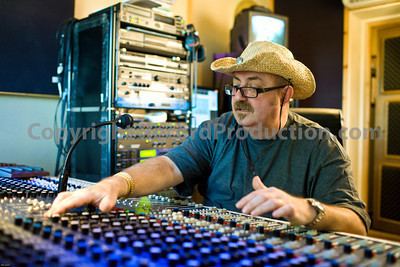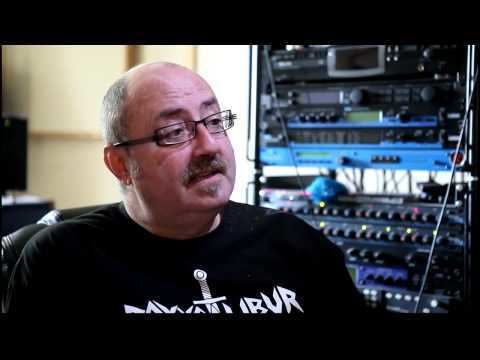Instruments Guitar Role Record Producer Name Chris Tsangarides | Labels Dark Lord Records Years active 1975-present Associated acts More | |
 | ||
Birth name Christopher Andrew Tsangarides Born 17 August 1956 (age 69) ( 1956-08-17 ) Occupation(s) Record producer, sound engineer, company owner, musician, songwriter Similar People Sacha Gervasi, Jeff Glixman, Stewart Levine, Chris Kimsey, Vic Coppersmith‑Heaven | ||
Chris tsangarides record producer interview with george shilling
Christopher Andrew "Chris" Tsangarides is a British Grammy-nominated record producer, sound engineer, and mixer. He is best known for his work with many heavy metal bands, including Judas Priest, Anvil, Gary Moore, Thin Lizzy, Helloween, Angra, Anthem, Yngwie Malmsteen and Tygers of Pan Tang. Tsangarides has worked with many pop and alternative artists as well, including Depeche Mode, Tom Jones, and Concrete Blonde.
Contents
- Chris tsangarides record producer interview with george shilling
- Chris tsangarides talks about thin lizzy gary moore judas priest anvil and more
- Career
- Technical accomplishments
- References

Chris tsangarides talks about thin lizzy gary moore judas priest anvil and more
Career

Chris Tsangarides learned to play piano as a child and studied trumpet at the Royal Academy of Music, before studying economics at college. He started his career in the music business in 1974, as an apprentice at Morgan Studios in London, one of the major independent recording studios in the UK at the time. Initially, he worked there as a tape operator and his first job as sound engineer was on Judas Priest's second album Sad Wings of Destiny in 1976. He engineered the British hit single "Naughty Naughty Naughty" in 1977, a pop song by Joy Sarney, whose success gave him much more work as engineer at the studio. In that period he engineered and mixed albums of new wave acts, such as Japan's Obscure Alternatives (1978), and jazz fusion releases of Colosseum II and Brand X. Tsangarides befriended Colosseum II guitarist Gary Moore, who requested him for his solo album Back on the Streets (1978) and gave him his first job as producer. The song "Parisienne Walkways", sung by Phil Lynott and contained in the album, was a hit in the UK. Tsangarides continued working with Moore on live albums and produced Back to the Blues in 2001.

When Morgan Studios 3 and 4 were acquired by Zomba Management in 1980 and rechristened Battery Studios, Tsangarides went to work for the new owners and became part of a team of "in-house producers" which included Robert John "Mutt" Lange, Martin Birch, Tony Platt and Nigel Green.

During the 80s and up to the 90s, Tsangarides became famous on the hard rock and heavy metal scene for the quality of his job and for having produced signature albums, like Anvil's Metal on Metal in 1982, Thin Lizzy's acclaimed final studio release Thunder and Lightning in 1983 and the Grammy nominated Painkiller by Judas Priest in 1990. He worked in those years with Black Sabbath, Ozzy Osbourne, Helloween, Y&T, Tygers of Pan Tang, Anthem, Sinner, King Diamond, Ian Gillan and produced also Bruce Dickinson's first solo album Tattooed Millionaire (1990).
Beside his work with metal bands, Tsangarides recorded songs for artists of other musical genres, like singer/songwriter Joan Armatrading, pop star Tom Jones, goth rockers The Lords of the New Church, Killing Joke and keyboardist Jan Hammer. In 1987, he remixed the song "Never Let Me Down Again" by synthpop band Depeche Mode for a release as single.
The 90s saw Tsangarides still at work with metal bands like Exodus, Overkill, Judas Priest again with the album Painkiller, the Japanese Loudness and guitar virtuoso Yngwie Malmsteen, but he also produced the British gothic rock act The Sisters of Mercy and the alternative rock groups The Tragically Hip and Concrete Blonde. For the latter band, he also produced and engineered the hit single "Joey" in 1990. In 1999, Tsangarides collaborated as a performer and songwriter with Shin Hae-chul in the techno/metal act Monocrom. They made one album and did an arena tour in Shin's native Korea.
At the beginning of the 2000s, Tsangarides had his own music company called Rainmaker Music, which included a recording studio with the same name in South London. He later opened another studio called The Dump in Kenley, Surrey, which operated until January 2006. Among others, New Model Army, Leanne Harte, Winters Bane and Glyder recorded there.
In 2006, Tsangarides opened a new recording facility, Ecology Room Studios in Kent, England, where he went on producing new and established acts on lower budgets than in corporate studios. The Strawbs, Mountain, Steeleye Span, The Quireboys, Biomechanical, Spit Like This, Savage Messiah and many other bands recorded at his new facility. LunarMile, whose members include Toni-Marie Iommi (daughter of Black Sabbath's Tony Iommi) and Alex Hill (son of Judas Priest's Ian Hill), recorded there in June 2007.
Tsangarides is featured in Sacha Gervasi's documentary film Anvil! The Story of Anvil, released in 2009, while at work on the album This Is Thirteen, which Anvil recorded at Ecology Room Studios.
In February 2012, Tsangarides announced details of a new record label Dark Lord Records formed with The Strawbs frontman Dave Cousins. The first release on the new label was Normalityville Horror by Spit Like This on 21 May.
Tsangarides occasionally plays guitar and performs live with the metal band Exmore / More 2012.
Technical accomplishments
Tsangarides is known for a guitar recording technique called "the vortex", which he first used when recording the guitar of John Goodsall for the Brand X album Moroccan Roll in 1977. He later refined the technique, which gives to the recordings a random panning effect similar to a reverb, but obtained through a particular placement of microphones.
